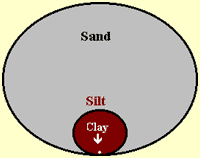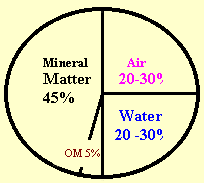
WHAT IS YOUR SOIL MADE UP OF?
To start our introduction to Soilcare it is necessary to first focus on the three parts that
made up your soil. By covering the A.B.C. of the soil we will have a better understanding of
some of the words and definitions used when discussing soil.
Your soil has 3 parts: P B C

  Your soil has 3 interrelated components: Your soil has 3 interrelated components:
P. Physical:
sand & clay etc
B. Biological:
roots, worms, bacteria etc
C. Chemical:
C, H, O, N, Ca, K, P etc
INTER-RELATIONSHIP OF SOIL ABC
The soil that we walk on and work with is part of a soil ecosystem, which has many related parts -
trees, bird, insects, grasses, water, rocks, sand, clay, earthworms, fungi, humus, etc.
The soil ecosystem that we farm and garden has been formed by the action of physical, chemical and
biological forces over thousands of years. These forces have a direct impact on the fertility and
productivity of agricultural soil and the profit derived from them.
The physical, chemical and biological aspect of the soil are also related. For example the water
that goes through the soil changes both the chemical and physical nature of the soil. If a soil
becomes water logged, it can become anaerobic [lack of air or oxygen] which means that anaerobic
soil organics can breed up and aerobic organisms die out or go into dormancy. As oxygen supplies
drop, carbon dioxide levels rise and this can be accompanied with a drop in soil pH, which in turn
can change the availability of individual elements [Zn, Mn, Cu & Mo, Se]
SOIL PHYSICS
Soil physics is made up of the solid [mineral and organic matter], gaseous and liquid phases of the
soil.
At this introductory level we will think about soil physics as the physical home of the plant and soil
life. The "soil house" is dominated by the so-called soil "solids."
The soil solids involve two parts:
- mineral [sand, silt & clay etc. = primary particles] &
- organic [organic matter & humus] fraction of the soil
The mineral part of the soil could be made up of:
- Sand being very big
- Silt being middle
- Clay being small
[Not to scale; Adapted from Schriefer, 1984]
|

|
Just minerals and organic matter does not make a soil. We also need to consider the gases and water that
fill the spaces between the individual particles. Therefore the non solid parts of the soil include the
liquid [soil air] and gas [soil water] parts.
An ideal soil should have the following percentages:
Volume composition of a loam soil
Mineral matter 45%
Organic matter 2-5%
Air should be 25%
Water 25%
[Adapted from Ghildyal & Tripathi, 1987 & Brady, 1990]
|

|
SOIL BIOLOGY
The biology of the soil can be thought of as the tenants of the soil.
Which sort of tenants do you want in your soil? The ones that have "wild parties" and wreck things
[disease], cause damage [pathogens] and cost you money. Or the ones that build your soil, increase
plant nutrient availability, raise nitrogen levels and generally improve the soil house. The
way we treat the soil dictates the soil biology that we literally culture in the soil. Good or
bad soil biology is largely due to good or bad sustainable soil management.
The Living Soil
A vast multitude of organisms live in the soil, a teaspoon of soil contains more soil
organisms than there are people on the earth. In a teaspoon of healthy soil you could have
100,000,000 bacteria, 50,000 meters of fungal hyphae [fungi feeder shreds], 100's of beneficial
nematodes and a baby earthworm or an egg capsula. Therefore, when we think of soil we need to
think often at a microscopic level. It has been said that there is often more "livestock" below
the ground than what there is on top. Neil Kinsey reminds us that even if we only grow crops,
we still have to look after your "underground" livestock even if its just the several millions of
earthworms that are hard working tenants. The range in size of soil biology can be from a tiny virus,
to a 150 millimetres of a earthworm, to more than 10,000 kilometres of a single plant's root system
[Anderson, 1992].
Let us take a look at the diversity of soil biology that makes up the soil [ecosystem]. In the soil
ecosystem we first need to divide things into being plants [flora] or animals [fauna]. At first this
may seem simple as a earthworm is an animal and a wheat plant is a plant, but when we get down to smaller
organisms the division is less obvious and difficult as some organisms can act a bit like a plant using
photosynthesis and a bit like an animal that internally digests food. At this introductory level we will
make the divisions as simple as possible.
|
Animals [Fauna]
Large plant eaters
Rodents: rabbits, mice
Medium plant eaters [Megafauna]
Insects: grubs, ants, springtails
Mites, Woodlice, Millipedes,
Slugs and snails, earthworms.
Medium predators [Macrofauna]
Insects: ants & beetles
Centipedes & spiders
Small predatory/parasitic/plant residues
Nematodes, Acari, Collembola
Rotifers
Protozoa [they eat bacteria] |
Plants [Flora]
Large
Roots of "higher" plants
Medium
Fungi Mushrooms
Microscopic [Microflora]
Fungi Yeast, Mycorrhiza and Moulds
Algae "Green" & Diatoms
Bacteria Aerobic & Anaerobic
Actinomycetes |
[Adapted from Hawksworth, 1990 & Buckman & Brady, 1966]
The information contained in this publication has been formulated in good faith, the contents do
not take into account all the factors which need to be considered before putting that information
into practice. Accordingly, no person should rely on anything contained herein as a substitute for
specific professional advice.
S.O.S. Rev 9.2 All rights reserved.
Contact: www.healthyag.com © Gwyn Jones 2001
On to page 2
PAGE
1 - 2 -
3
|

![]() Home
Home![]()
![]() History
History![]()
![]() Catalogue
Catalogue![]()
![]() Courses
Courses![]()
![]() Top Ten
Top Ten![]()
![]() Links
Links![]()
![]() Site Map
Site Map![]()
![]() Contact
Contact


